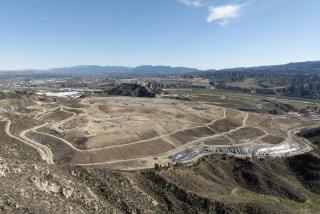Schabarum Wants Incinerator Plans Shelved
- Share via
County Supervisor Pete Schabarum Wednesday urged directors of the county Sanitation Districts to withdraw their plan to build a trash incinerator at the Spadra landfill in Pomona until each area of the county begins handling its own trash.
The recommendation was contained in a letter hand-delivered to the Sanitation District’s office minutes before directors began meeting Wednesday. The letter was read to directors but they deferred a response until July 20, when the staff will submit a new report on the incinerator project.
Schabarum noted in his letter that landfills in the San Gabriel Valley receive 60% of the county’s trash. He said the Sanitation Districts should concentrate on helping each area of the county manage its own trash. He said priority should be given to opening dumps in Mission and Rustic-Sullivan Canyons in the western part of the county.
“Until such time as these facilities have been opened,” Schabarum said, “I believe it is futile to consider disposal alternatives” at existing landfills “regardless of any technical merits or advantages.”
Pomona Mayor Donna Smith welcomed Schabarum’s letter. She said the public is not willing to accept a refuse-to-energy plant at the Spadra landfill.
Earlier this week, officials at Cal Poly Pomona withdrew their support of the project until their concerns about its impact on public health can be allayed.
And the Pomona City Council, which backed the project in 1985, took a step that could give the city the power to kill the project.
The new difficulties for the proposed incinerator arose this week after a hearing Saturday by the South Coast Air Quality Management District disclosed strong public opposition to the proposal, which will have to survive a long, complicated process before the air board before construction can begin.
The county Sanitation Districts are seeking a permit from the air quality district to build an incinerator that would burn 1,000 tons of trash a day to generate electricity for sale to Southern California Edison Co.
The Pomona Planning Commission issued a conditional use permit for the plant in 1985, but the City Council this week directed the commission to review new information to determine whether a supplementary environmental impact report should be prepared, requiring a new round of hearings.
City Atty. Patrick J. Samson said that the council cannot legally withdraw the permit granted two years ago, but that if new facts about the project have emerged, the city can order the Sanitation Districts to prepare a supplemental environmental impact report and impose new conditions. If there are new environmental problems that cannot be overcome, he said, the Sanitation Districts would be unable to build the plant.
In addition, the Pomona council this week directed the city staff to prepare a resolution limiting dumping at the Spadra landfill to trash from Pomona and neighboring cities.
Jim Stahl, assistant general manager of the Sanitation Districts, said the agency cannot legally close its landfills to any of its 76 member cities. But, he said, the proposed refuse-to-energy plant could limit service to the local area by signing disposal agreements with neighboring cities.
Stahl said the existing environmental impact report “covers all the issues” and he sees no need for a supplement.
The Sanitation Districts remain committed to the refuse-to-energy project, Stahl said. “Technically, this is an extremely sound project, and as a staff we’re very proud of it,” he said.
Deficiencies Found
In considering whether to require a supplementary environmental impact report, the Pomona Planning Commission will review information on the refuse-to-energy project, including a new report by five Cal Poly Pomona faculty members. The panel found deficiencies in the health risk assessment prepared for the Sanitation Districts by a private company.
Bruce F. Grube, provost and academic vice president of Cal Poly Pomona, said that the faculty report “points to a number of uncertainties” about the incinerator’s impact on public health and that until these questions are resolved, the university opposes a construction permit for the plant.
“The university is not unalterably opposed” to the project, Grube emphasized, “but we need a lot of additional study.”
The South Coast Air Quality Management District board at its hearing Saturday also sought additional study when it referred the Sanitation Districts’ health risk assessment to the state Department of Health Services and the state Air Resources Board for review.
Confidence in Study
Steve Maguin, who heads the Sanitation Districts’s solid waste management department, said he is confident that further scrutiny will uphold the findings of its health risk study, which concluded that small amounts of cancer-causing chemicals emitted from the plant would be unlikely to cause any additional cases of cancer among nearby residents. Maguin noted that the study was prepared in consultation with the air quality district and reviewed by a company recommended by the state Department of Health Services.
The health study and air emissions from the plant will be the focus of the air quality district’s hearings. Curtis Coleman, district legal counsel, opened the hearings Saturday by warning participants that the proceedings will be so technical and legalistic that all parties involved should consult lawyers.
Coleman said the hearings will be conducted like a court trial, taking evidence under oath. The issue, he said, will not be the popularity of the project but whether it complies with air pollution regulations.
More than 250 people attended the initial hearing Saturday, which laid the groundwork for subsequent meetings and showed that the project will face strong opposition from politicians, environmentalists, citizens groups and residents.
No one spoke in favor of the project except officials from the Sanitation Districts. Opposition statements drew strong applause.
‘Dangerous Pollution’
Rep. David Dreier (R-La Verne) and other opponents of the project called for a new emphasis on recycling.
Stahl said his agency believes that recycling alone cannot take care of the problem and that the county also needs refuse-to-energy plants and additional landfill space. The Sanitation Districts have estimated that the county will run out of disposal facilities in six years unless refuse-to-energy plants are built, new dumps are created or existing dumps are expanded.
The air quality district hearing will resume July 25. The construction permit from the air quality district and the conditional use permit from the City of Pomona are the two key permits required for the refuse-to-energy project.
Officials at Cal Poly said the university has no power to prevent the plant from being built, though it owns most of the Spadra landfill.
The university endorsed the refuse-to-energy project in principle in 1985 when it signed an agreement with the county and the Sanitation Districts authorizing the use of 74 acres of the campus for expansion of the Spadra landfill. In exchange, Cal Poly was given ownership of most of the landfill property, excluding the refuse-to-energy site, and began planning recreational and other uses for the property after the dump is closed.
Cal Poly also receives $150,000 a year from the Sanitation Districts for landfill-related research under an agreement that is in force for the life of the landfill, which will close in 1998 unless the refuse-to-energy plant is built.
Grube said the agreements have not undercut the independence of the university, which reserved the right to review the refuse-to-energy project as more information became available. After the air quality district staff announced in May that the project had met air pollution requirements, Grube said, the university appointed a committee of five faculty members trained in chemistry and mathematics to review the project.
Panel Found Flaws
Scott Pattison, head of Cal Poly’s chemistry department, said that he was “impressed with the detail of the (health assessment) report” but that the panel nevertheless found flaws.
The panel said the report had inadequate data to justify its air emission figures and failed to take differences in atmospheric conditions into account. The panel said the uncertainties could raise the maximum cancer risk estimated in the report from 4.2 chances per million to 42 chances.
Pattison said he would not attempt to say what might be an acceptable level of risk.
Even at 42 chances per million, the cancer risk from living near the Spadra plant would be lower than many everyday risks. For example, the possibility of developing cancer from drinking a pint of milk a day is calculated at 140 chances per million because of a suspected carcinogen, aflatoxin, and the lifetime cancer risk from cosmic radiation incurred by taking one transcontinental flight a year is estimated at 70 chances per million, according to the health assessment report.
Cancer Seen Unlikely
The health report said it was unlikely that anyone living near the Spadra incinerator would actually develop cancer from the plant. The average risk was put at 1 in 50 million. To have the maximum risk of 4.2 chances per million, a person would have to live near the incinerator for 70 years, eat 35% of his fruits and vegetables from a backyard garden, eat fish from the nearby Puddingstone Reservoir and keep the windows of his house open at all times.
Stahl said the staff of the Sanitation Districts will meet with the Cal Poly group to discuss the questions that have been raised. “I believe we have the answers to each one of their concerns,” he said.
Grube said Cal Poly believes that the Sanitation Districts should not only provide more health risk information but should also obtain more air emission data from the Commerce refuse-to-energy plant before obtaining a permit to build the Spadra facility.
Delay Urged
Mayor Harvey Holden of the City of Walnut, which adjoins the landfill, earlier said the project should be delayed until it can be determined whether the Commerce plant, the first waste-to-energy plant in the county, is polluting the air. Holden said that since the effectiveness of air pollution control equipment on the plant could diminish with time, two or three years of testing should be required before a plant is built at Spadra.
The Sanitation Districts this week announced the first results of extensive measurements of pollutants coming from the Commerce plant, which opened this year and burns up to 400 tons of rubbish a day. The districts said the plant is releasing lower amounts of pollutants than expected.
“The preliminary results are extremely encouraging,” said Stahl.
Michael Selna, manager of the Commerce refuse-to-energy project, said the tests, conducted in late May, show that the Commerce incinerator is releasing only 5% to 50% of the carbon monoxide, nitrogen oxides and sulfur dioxide that are allowed. These pollutants are ingredients in smog.
Selna said the results are preliminary and have not yet been analyzed by the South Coast Air Quality Management District. In addition, he said, test results have not yet been obtained for dioxins and furans, cancer-causing chemicals that have been a major concern of those who claim mass-burn incinerators are dangerous.
More to Read
Sign up for Essential California
The most important California stories and recommendations in your inbox every morning.
You may occasionally receive promotional content from the Los Angeles Times.










